Coverage Carousel
Analytics Report: Birds DC Sean Desai Prefers Wide Variety Of Coverages
Sean Desai, the first-year Eagles defensive coordinator, has been tasked this season with producing a championship-cailber unit despite inherting an almost entirely remade unit than the one his predecessor, Jonathan Gannon, led in helping the Eagles reach the Super Bowl last year.
Desai, the former Bears defensive coordinator who was heavily influenced by Vic Fangio, was given almost an entirely new group of linebackers,safeties and nickel cornerbacks who weren’t a part of last year’s NFC Championship team.
After spending last year as an associate head coach in Seattle under Pete Carroll, along with the title of defensive assistant, Desai edged in-house Eagles candidate, defensive backs coach Dennard Wilson, to become the Eagles’ coordinator.
The bold decision by head coach Nick Sirianni resulted in Wilson leaving and taking the same position in Baltimore.
Along with personnel losses and Wilson’s departure, the Eagles also needed to replace their linebackers coach and for the first time hired a nickelback coach. They also hired former Patriots defensive coordinator Matt Patricia as a defensive assistant.
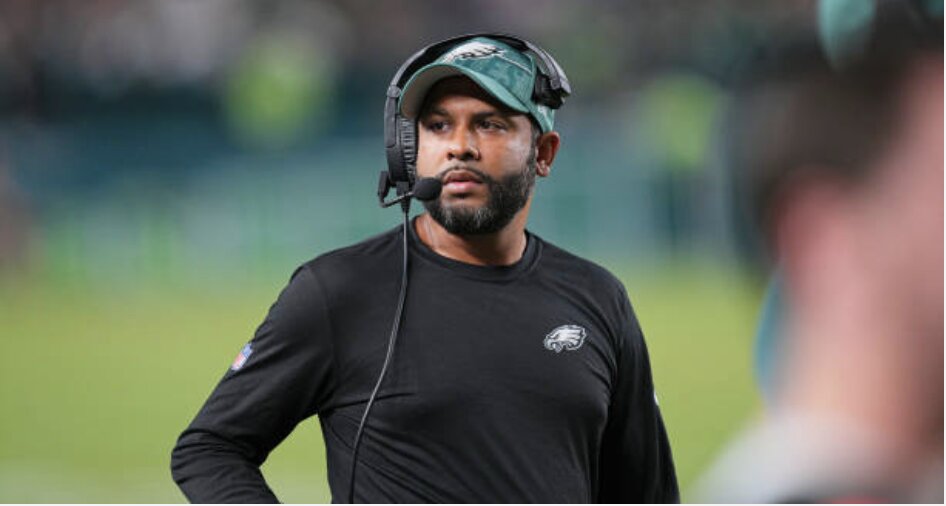
GETTY IMAGES: In his first year, Eagles DC Sean Desai has shown to prefer mixing several coverages.
The Fangio influence on Desai’s scheme is obvious.
Like Fangio, Desai deploys multiple fronts and coverage, alternating between five-man and four-man defensive lines based on down-and-distance scenarios and using sudden movement in the back end to make quarterbacks see a different picture pre- and post-snap.
Through 11 games, Desai has shown a willingness to play up to nine different coverage within a single game, a deviation from Gannon’s approach.
Like Gannon, Desai is a selective blitzer with a pressure rate that hovers around the middle of the league.
He typically blends concepts of Cover 3, Cover 4, Quarters, Cover 2 Zone, Two Man, Cover 1 Man, Cover Zero along with some other coverages and pressures.
What stands out is that Desai rarely calls the same coverage on back-to-back snaps, and often alternates personnel within certain coverages to present a different look even within a similar alignment.
Some of his coverages and personnel groupings are the result of myriad injuries that Eagles have encountered this season, forcing him to play reserves and rookies at positions they haven’t played before or to rotate with others, and some are simply intended to capitalize on a specific player’s strength or minimize another player’s weakness.
In our attempt to showcase the wide variety of coverages Desai has played, we charted every snap from the past three games to gain a better understanding of which coverages Desai leans mostly on and how many different coverages he’s willing to call in any one game.
The Eagles are 2-1 in last three games – against Kansas City, Buffalo, and San Francisco – and have allowed 93 total points and 1,297 yards in that span.
The objective of this analytics-based piece is to outline Desai’s scheme preferences, not to make any conclusions about his job performance this year but for context, it’s important to show the results of the small sample used to chart Desai’s coverages:

Also worth noting is that during this three-game sample size, the Eagles were hit with another injury at linebacker, were already thin at safety and were on the field longer than usual because of the offense’s atypical stagnancy.
The Eagles are in the midst of a brutal schedule stretch that has them pitted against five consecutive teams that made the playoff last year, including last year’s Super Bowl champion and last year’s NFC Championship foe.
Despite these challenges, Desai has still crafted a blend of coverages in various situations, leading to less predictability and, in some cases, more defensive success.
Desai thrives when he’s able to disguise and change coverage in any scenario.
Let’s look at his coverage breakdown against the Chiefs from Week 11:
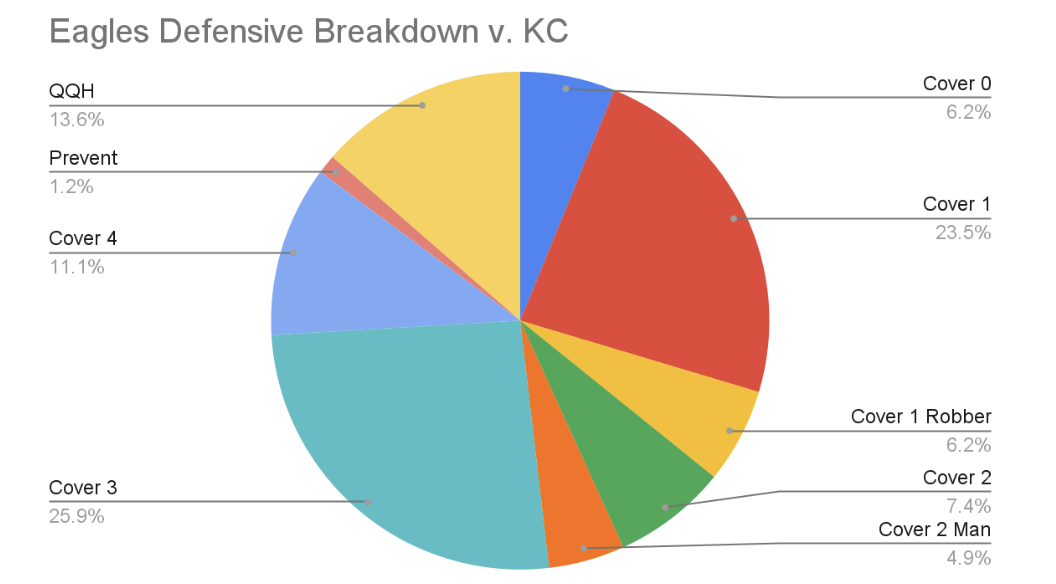
Against the Chiefs, the Eagles stayed mostly in Cover 1 (29.7%) with Cover 3 being the second-most used shell (25.9%).
When the Eagles ran Cover 1 Robber, they mostly bracketed All-Pro tight end Travis Kelce.
This form of man coverage generally has a free player in the middle of the field, but the coaching point for this week – based on tape evaluation – was clearly to double Kelce.
The Eagles also sprinkled a healthy amount of other coverages at the Chiefs including Cover 4, Cover 2, Quarters (also known as Quarter-Quarter-Half or QQH in the graphic), and Cover 0.
In this game alone, Desai played nine different coverages.
A week later, against the Bills and dual-threat quarterback Josh Allen, Desai again mixed his coverages:
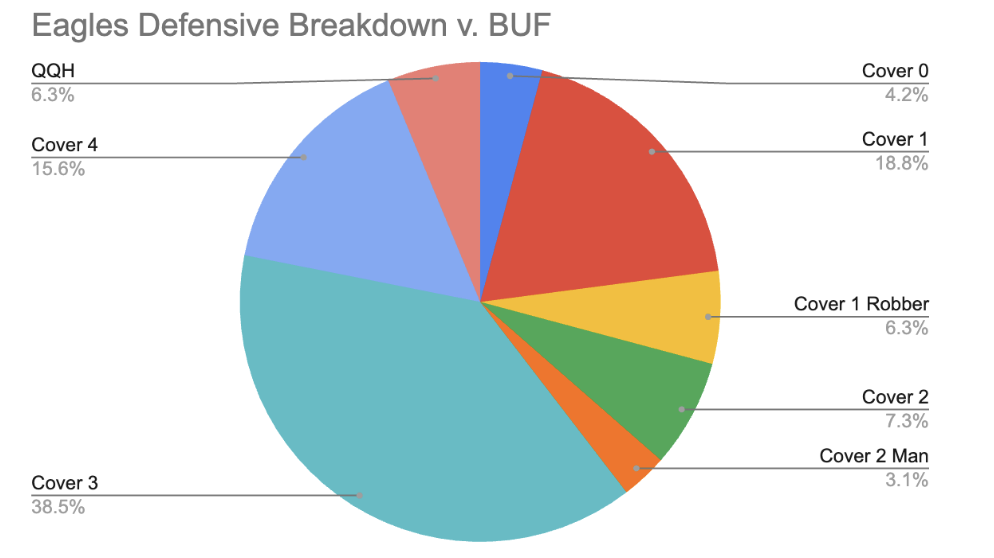
Against the Bills, the Eagles played less man – which makes sense given Buffalo’s playmakers at wide receiver against the Eagles’ depth-tested secondary.
The Eagles played significantly more Cover 3 (38.5%) than they played against the Chiefs, about 13% more.
The Eagles defense gave up more yards and points to the Bills, but several of Buffalo’s biggest plays came from Allen’s ability to buy time by moving out of the pocket.
This game showcased a tendency that would be evident the following week against the 49ers, a rematch of last year’s NFC Champiponship.
When the Eagles’ defense struggles, Desai leans into his base Cover 3.
The Eagles also ran more Cover 4 against the Bills than the Chiefs, another attempt to keep Bills wideouts from beating the defense over the top.
Let’s look at Desai’s coverages breakdown this past Sunday:
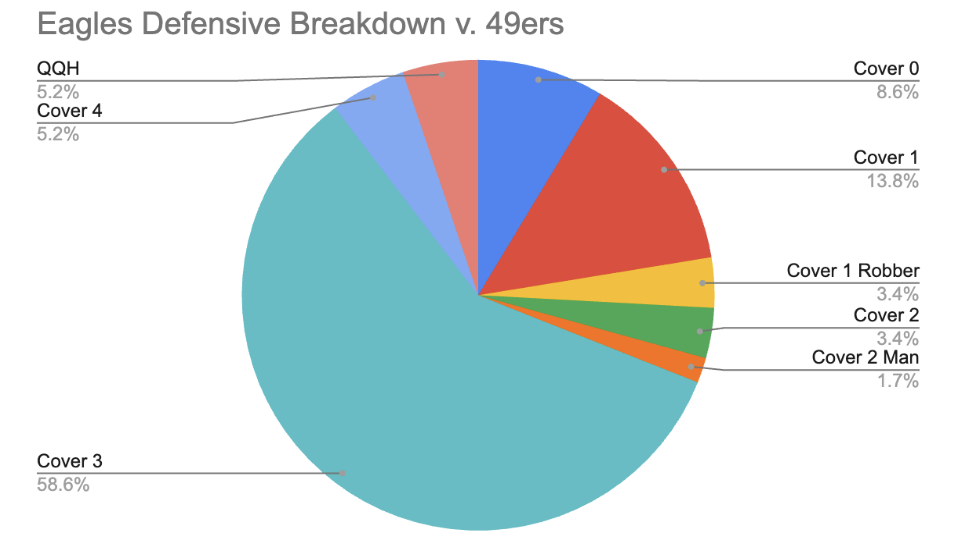
The Eagles stuck to Cover 3 at 58.6% clip – significantly higher than against the Bills and Chiefs.
Cover 1 was Desai’s next most prevalent coverage, but it was not used close to the rate it was in the Chiefs and Bills games.
This could be the result of Desai’s decision to dial up more pressure on Brock Purdy in the second half, as Purdy’s comfort in the pocket led the Niners in the second quarter began a stretch of scoring touchdowns on six straight possessions.
Desai’s decision to play a predominant coverage (Cover 3) after far more mixing in the previous weeks could have been the result of the 49ers’ torrid scoring pace or perhaps was pre-planned going into the game in response to the Niners’ multitude of weapons.
Desai could’ve foreseen the difficulty for his defense to play man coverage against the prolific Niners compared to the Chiefs and Bills, who have both struggled at times this year to move the chains.
Also, 49ers coach Kyle Shanahan is known as the NFL’s top space-creating offensive mind. Desai might have felt most comfortable with his bread-and-butter Cover 3 look as the best possible matchiup.
Desai did run some interesting Fire Zone blitzes 3 – a five-man rush with three interior defenders and three deep defenders – but those pressures still came from within the Cover 3 family.
It’s also possible that Desai sought to simplify his defense against a heavy motion/misdirection as he also did earlier this year against the Dolphins and Rams.
What’s It Mean?
When the Eagles panic, they go back to their base: Cover 3.
When the defense is successful, it’ll blend several different looks into the mix. But when in doubt you’ll see the Eagles in Cover 3.
However, their Cover 3 look is often disguised – Desai will show two-high safeties pre-snap – or married with unique blitzes in a Fire Zone 32 look, which the Eagles showed against all three teams.
Outlook
Regardless, the Eagles defense needs to make changes. In fact, they already did, as on Tuesday they signed linebacker Shaq Leonard, a former three-time All Pro linebacker who was waived by the Colts.
It’s unclear how much Leonard will contribute against the Cowboys. Eventually, Leonard will have a role in an injury- and talent-depleted unit.
Leonard should provide some versatility that will allow Desai to continue mixing coverages, which earlier in the year created success for the Eagles’ defensive unit.
The Eagles should also eventually get linebacker Zach Cunningham back from his hamstring injury, which should help the defensive significantly.
Ultimately, the Eagles look to respond from their blowout loss against the divisional rival Dallas Cowboys.
The Cowboys are coming off an outstanding offensive performance against the Seattle Seahawks, who run a similar scheme to Desai’s.
The Cowboys also have additional rest after playing on Thursday night football.
Regardless, this matchup will be telltale for the Eagles’ defense, but also for the team overall.
This game will be a test of the team’s resilience and an indication of whether they’re still among the NFL’s elite or about to enter a tailspin.
– Sam Finkel is a staff writer for InsideTheBirds.com who focuses on analytics.


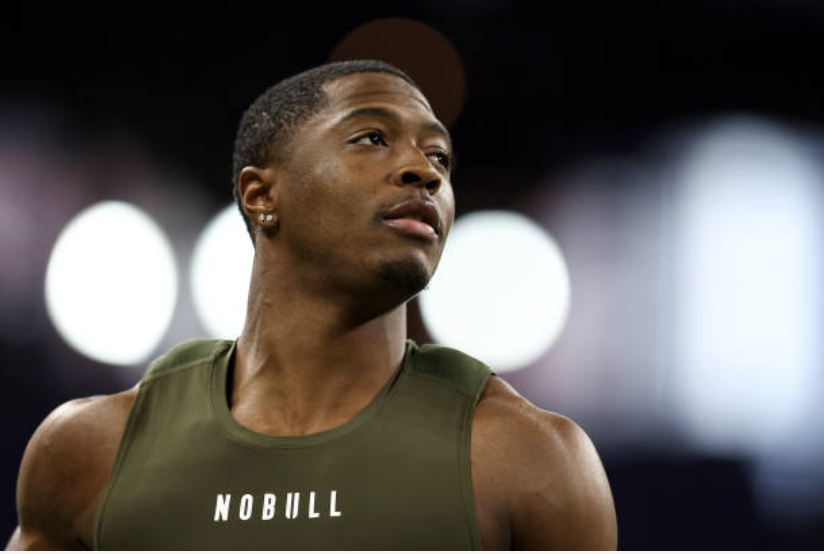
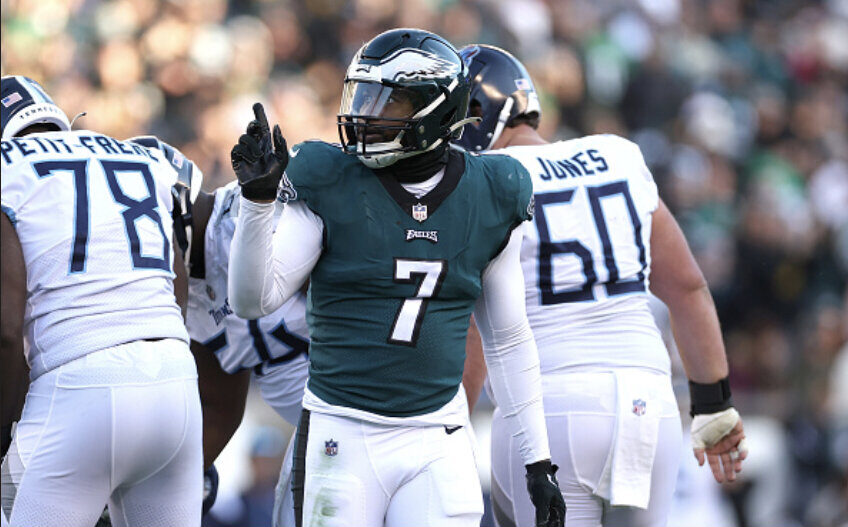
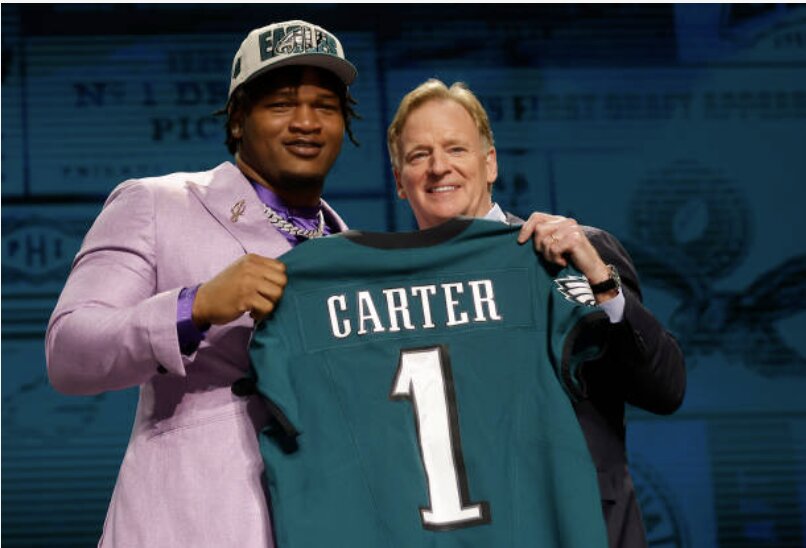
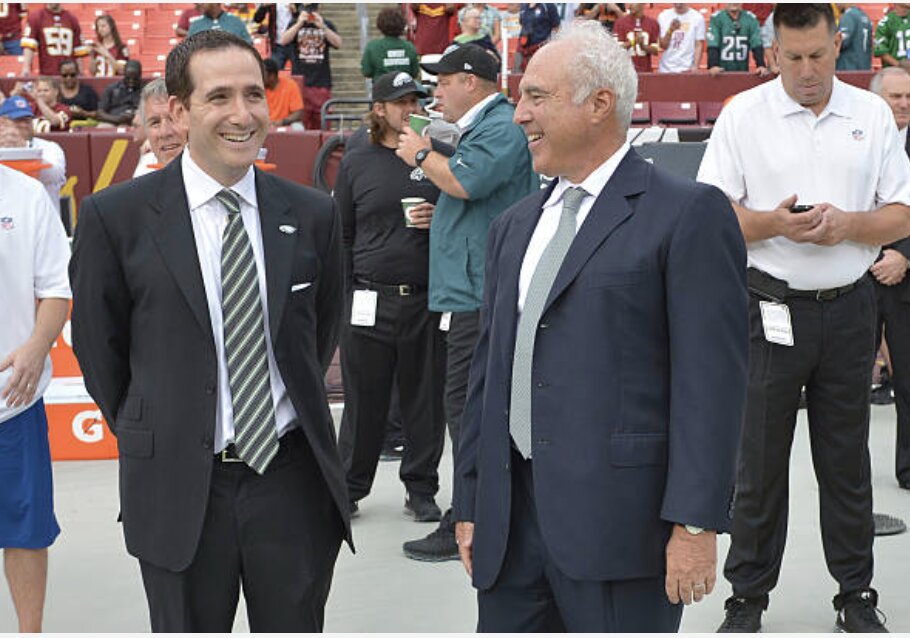
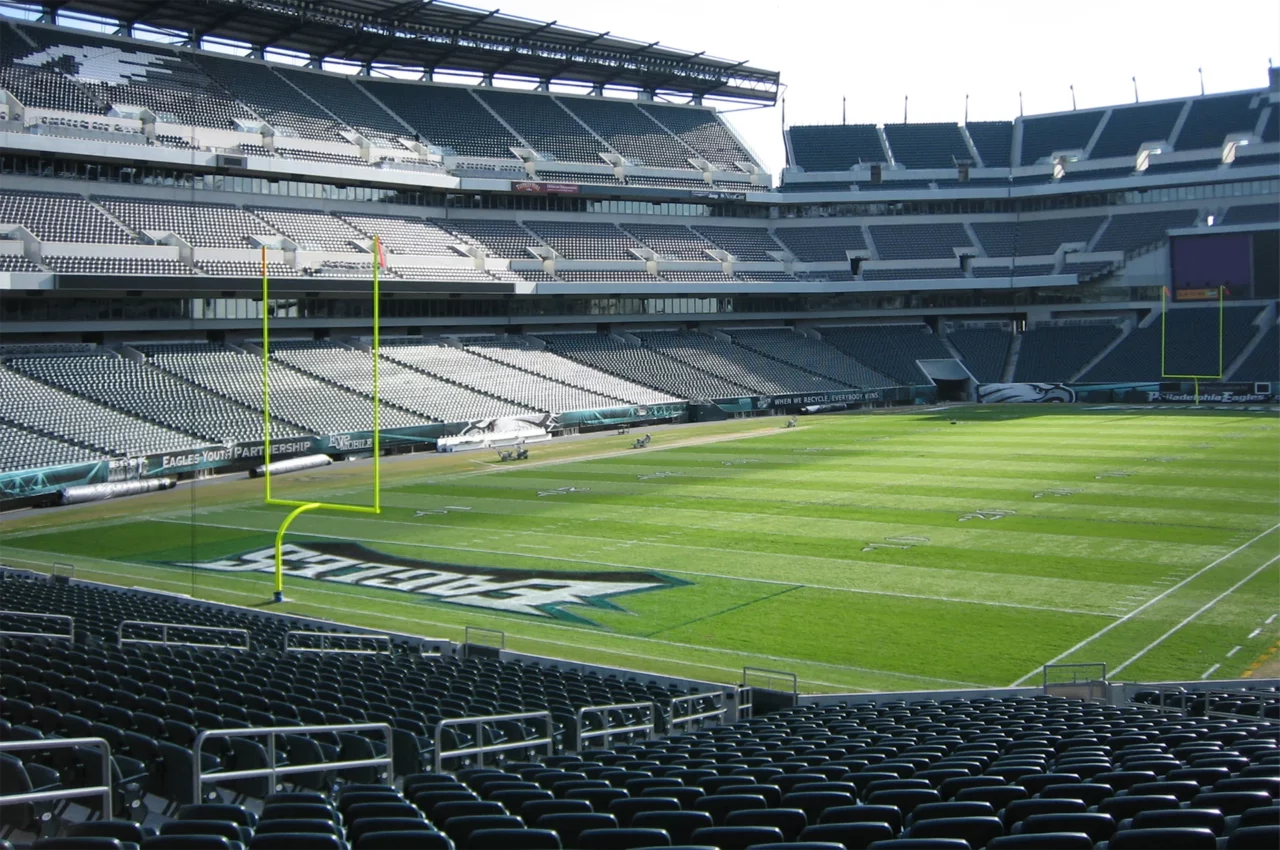
2 Comments
Professor Kenneth A. Jacobsen
Extraordinary work and analysis by Sam!!
Janice
Very impressive article and analysis!